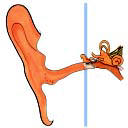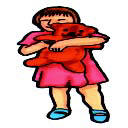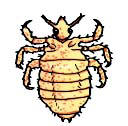Bronchitis
 Bronchitis
is an infection of the airway. It can be acute, with a rapid
onset, or chronic, with recurrent episodes. While not
life-threatening, complications can lead to pneumonia.
Bronchitis
is an infection of the airway. It can be acute, with a rapid
onset, or chronic, with recurrent episodes. While not
life-threatening, complications can lead to pneumonia.
Signs and symptoms are: dry
cough, slight fever (approx. 38oC), mild chest discomfort,
wheezing and uncomfortable respirations.
Treatment is with medication, so
contact your doctor for advice, especially when very young
children are affected, or if the condition is recurrent.
Chickenpox (Varicella)
Chickenpox is very contagious. It
is a viral disease, usually mild in children. To date, no
successful preventative inoculation has been developed, so the
disease is widespread throughout the population. Complications
from the disease are rare, and are usually restricted to
infections of the Chickenpox blisters.
Signs and symptoms are; mild
fever (38-40oC), illness for 1 or 2 days, skin eruptions or
blisters that appear anywhere on the body, including the
mouth, nose, penis, vagina and the head. Limbs are least
affected. The blisters form scabs after 24 hours, and new
blisters appear every 2 - 3 days.
The application of cool
compresses reduces the `itchiness' of the blisters and
discourages scratching by the child. Contact your GP or local
child health centre for advice.
Cold Sores (Herpes Simplex)
Cold sores are a common viral
infection, and are very contagious. Generally, the lips,
mouth, and sometimes the genitals are affected. In some rare
instances, the cornea of the eye is also affected. The virus
is transmitted by person-to-person contact, or by contact with
an infected person's saliva or discharge from the sore. The
blisters are contagious until they heal. The virus remains
dormant in the system for months before `flare up', and it is
usual for the disease to recur periodically.
 Signs and
symptoms are; eruptions of small blisters grouped together,
pain at the affected site, blisters are surrounded by reddened
tissue. If the eye is affected; pain and redness to the eye,
eye discomfort and sensitivity to light. A `flare up' is
common after prolonged exposure to the sun.
Signs and
symptoms are; eruptions of small blisters grouped together,
pain at the affected site, blisters are surrounded by reddened
tissue. If the eye is affected; pain and redness to the eye,
eye discomfort and sensitivity to light. A `flare up' is
common after prolonged exposure to the sun.
Contact your GP, especially
during the first incidence. Treatment is usually by medication
to hasten the healing of the blisters. It is crucial that a
doctor is consulted immediately if you suspect that the eye is
affected.
Cradle Cap
Cradle cap is a yellow
encrustation on the scalp of an infant caused by
overstimulation of oil glands in the child's skin. It is a
mild form of dermatitis. It is NOT
due to poor hygiene, and is generally caused by extreme
weather conditions, infrequent or incorrect (adult strength)
shampoos, or associated skin disorders.
 Signs and
symptoms are; thick, yellowish scales on the child's scalp,
associated reddening, may be some discomfort and itching in
extreme cases.
Signs and
symptoms are; thick, yellowish scales on the child's scalp,
associated reddening, may be some discomfort and itching in
extreme cases.
Use of baby soap and shampoo,
with mild scalp massage will loosen the scale. If the
encrustation will not loosen easily, apply baby oil and warm
cloths to the scalp before massaging. If the condition does
not respond to this treatment, contact your local child health
centre for advice.
Middle Ear Infection
Middle ear infections are usually
associated with either viral or bacterial infections, which
invade the ear from the nose and throat. Other causes may be a
blockage of the sinuses and tubes by infection, or by
infection introduced through a ruptured eardrum. This type of
infection is common to infants and the very young.
 Signs and
symptoms are; earache, pulling at the ear, mild fever,
irritability, hearing loss. BE AWARE
THAT AN INCREASE IN FEVER MAY LEAD TO FEBRILE CONVULSIONS.
Signs and
symptoms are; earache, pulling at the ear, mild fever,
irritability, hearing loss. BE AWARE
THAT AN INCREASE IN FEVER MAY LEAD TO FEBRILE CONVULSIONS.
Contact your GP or local child
health centre for advice. Antibiotics may be required to
arrest the infection.
Earwax Blockage
Earwax blockage is due to the
overproduction of wax by glands in the outer ear. Wax is
produced normally as a form of protection for the ear canal
and the eardrum. Overproduction of wax can cause a complete
blockage of the ear canal with associated hearing loss.
Signs and symptoms are; decreased
hearing, visible quantities of wax in the ear canal, `ringing'
in the ear, and (rarely) pain in the ear.
 Wax can be
removed with non-prescription eardrops. Instill the drops into
the child's ear in accordance with directions on the
container. Avoid `flushing' the child's ear with water or
other fluids by using pressure. Any fluids introduced into the
ear should be carefully allowed to `run' into the ear canal.
If, after treatment, the ear does not appear clear, or hearing
has not returned to normal, contact your GP for advice. DO NOT
attempt to remove wax from the ear canal with cotton buds or
other devices. This may cause damage to the ear and will
compact the wax further into the canal.
Wax can be
removed with non-prescription eardrops. Instill the drops into
the child's ear in accordance with directions on the
container. Avoid `flushing' the child's ear with water or
other fluids by using pressure. Any fluids introduced into the
ear should be carefully allowed to `run' into the ear canal.
If, after treatment, the ear does not appear clear, or hearing
has not returned to normal, contact your GP for advice. DO NOT
attempt to remove wax from the ear canal with cotton buds or
other devices. This may cause damage to the ear and will
compact the wax further into the canal.
Head Lice (Pediculosis)
Pediculosis is inflammation of
the skin caused by tiny parasites (lice) which congregate in
the hairy parts of the body, which in children is the scalp.
The lice bite through the skin to obtain blood, causing red
bite marks, and lay their eggs attached to the hairs (`nits').
Head lice are spread by contact with an infested person or
clothing. Head lice are common to pre-schools and schools,
irrespective of the social standing of the establishment.
 Signs and
symptoms are; itching and scratching, scalp inflammation,
active lice and `nits' in the scalp hair, (rarely) enlarged
lymph glands in the neck.
Signs and
symptoms are; itching and scratching, scalp inflammation,
active lice and `nits' in the scalp hair, (rarely) enlarged
lymph glands in the neck.
Contact your local child health
centre or GP for advice. Treatment is generally by medicated
shampoos and creams. Ensure that treatment is continued for at
least five days after the lice disappear, as they can recur.
Be sure to tell the child's school or pre-school, and
playmates' families so that they can take precautions.
Measles
The common form of measles (`red
measles') is a serious viral illness that infects the skin
and, more importantly, the respiratory tract. Measles is very
contagious, and is fatal to those communities that have no
historical immunity, such as indigenous populations. The
incubation period is 7-12 days after exposure, and possible
complications associated with the disease are pneumonia,
meningitis or encephalitis. Measles is becoming more common in
the community after a period of low incidence. It is
preventable by immunization.
 Signs and
symptoms are; fever (39oC+), sneezing and runny nose, harsh,
hacking, dry cough, red eyes sensitive to light, white spots
in the mouth and throat, red rash spreading from the ears and
forehead to the rest of the body.
Signs and
symptoms are; fever (39oC+), sneezing and runny nose, harsh,
hacking, dry cough, red eyes sensitive to light, white spots
in the mouth and throat, red rash spreading from the ears and
forehead to the rest of the body.
Contact your GP for treatment and
advice. Encourage the child not to watch TV or read as this
exacerbates the child's sensitivity to light and makes the
eyes irritable. Keep constant observation of the child's
temperature.
German Measles (Rubella)
Rubella is a viral illness,
usually mild in onset. The danger with this illness is in the
spread to pregnant women. A woman who contracts Rubella in the
first 3 or 4 months of pregnancy is at risk of giving rise to
severe defects in the unborn child. Rubella is preventable by
immunization, and all non-pregnant females of childbearing age
should be immunized.
Signs and symptoms are; slight
fever, muscle aches, stiff neck, fatigue, slight red rash on
the child's head and body after 2-3 days, swollen neck lymph
glands.
Contact your GP for advice.
Ensure that your child does not have known contact with
pregnant women. The child usually recovers within a week.
Meningitis
Meningitis is a term used to
indicate inflammation of the thin membrane that covers the
brain and spinal cord. Meningitis can be caused by viral
(Aseptic Meningitis), or bacterial (Spinal Meningitis)
infections. It can also be caused by exposure to certain fungi
(yeasts), and by reaction to other viral infections such as
Measles. Viral meningitis is contagious, and becomes more
virulent as it spreads.
Signs and symptoms are; fever
(39oC or greater), sweating, chills, headache, irritability,
eyes sensitive to light, stiff neck, vomiting, confusion,
lethargy, may have sore throat, may have red skin rash.
 Should your
child exhibit some of the above signs and symptoms, and you
are suspicious of his or her ability to respond appropriately,
take the child to hospital. If the child is feverish, vomiting
and drowsy, CALL AN AMBULANCE.
Remember that meningitis involves hospitalization, so the
earlier you contact the experts, the better.
Should your
child exhibit some of the above signs and symptoms, and you
are suspicious of his or her ability to respond appropriately,
take the child to hospital. If the child is feverish, vomiting
and drowsy, CALL AN AMBULANCE.
Remember that meningitis involves hospitalization, so the
earlier you contact the experts, the better.
Mumps
Mumps is a viral disease which
causes swelling of the salivary glands. The virus is
transmitted person-to-person, and has an incubation period of
14 - 20 days after contact. Mumps is most common in children
between the ages of 2 and 12 years, though adults are
susceptible to the virus. Immunization is available.
Signs and symptoms are; mild
fever, headache, very sore throat, painful swelling of the
salivary glands (between the ear and jaw). Complications
involve swelling of the testicles (males), and abdominal pain
(females).
Contact your GP for advice. There
is no definitive medication for the infection. The affected
child requires careful observation to ensure that
complications such as meningitis or swollen testicles do not
go untreated.
Thrush (Oral Thrush)
 Thrush
is a common fungus infection of the mouth, especially
affecting the newborn and infants. It affects the mouth,
tongue, gums and soft palate. Occasionally, the lips and
cheeks are affected. Thrush is caused by a fungus called
Candida Albicans, and is due to the newborn picking up a yeast
infection from the mother when passing through the birth
canal, or in infants, by acquiring some foreign substance
which upsets the balance of organisms in its mouth. It is
likely to recur.
Thrush
is a common fungus infection of the mouth, especially
affecting the newborn and infants. It affects the mouth,
tongue, gums and soft palate. Occasionally, the lips and
cheeks are affected. Thrush is caused by a fungus called
Candida Albicans, and is due to the newborn picking up a yeast
infection from the mother when passing through the birth
canal, or in infants, by acquiring some foreign substance
which upsets the balance of organisms in its mouth. It is
likely to recur.
Signs and symptoms are;
white/yellow patches in the mouth, dry mouth, and small ulcers
if the patches are wiped off.
Ensure that the child's eating
utensils, teats, etc. are boiled to prevent passing the thrush
on to others. Swab the child's mouth with non-prescription
mouthwash available from a pharmacy. If the thrush does not
clear up within 3 days, contact your child health centre for
advice.
Tonsillitis (Pharyngitis)
Tonsillitis is the inflammation
of the lymph tissue at the back of the throat. Tonsils are at
their largest, and most susceptible to infection, between the
ages of 4 years and puberty. Tonsillitis is contagious and is
caused by either viral or bacterial infection.
 Signs and
symptoms are; pain in the throat, difficulty swallowing,
chills, fever (40oC or greater), swollen glands above the jaw,
headache, earache, (rarely) cough.
Signs and
symptoms are; pain in the throat, difficulty swallowing,
chills, fever (40oC or greater), swollen glands above the jaw,
headache, earache, (rarely) cough.
Contact your GP or child health
centre for advice. Some infections indicate that antibiotics
may be required. Repeated bouts of tonsillitis may necessitate
surgery to remove the tonsils.
Intestinal Worms
The common intestinal worms that
infest children are; tapeworm, roundworm and threadworm. Worms
are intestinal parasites that have different breeding cycles
and depend on the human host in order to live and reproduce.
Eggs of the worms are introduced into the child's body by
various means, e.g.. pets, dirt, uncooked food, contact with
an infected person. The systems of the body affected are the
stomach, intestinal tract, bowel, and lungs. Although parents
may deny it, most children at one time or another, become
infested with the parasites.
 Signs and
symptoms are; loss of appetite, weight loss, restless sleep,
nocturnal teeth grinding, irritation and itching around the
anus, diarrhoea, (rarely) abdominal pains/cramps, and (in the
case of roundworms) dry cough.
Signs and
symptoms are; loss of appetite, weight loss, restless sleep,
nocturnal teeth grinding, irritation and itching around the
anus, diarrhoea, (rarely) abdominal pains/cramps, and (in the
case of roundworms) dry cough.
The most effective treatment is
regular ingestion of non-prescription anti-worm medication.
Taken by the entire family on a regular basis, medication will
break the reproductive cycle of any parasites ingested by
humans. Ensure that the household pets are dosed regularly
with animal worming medication.